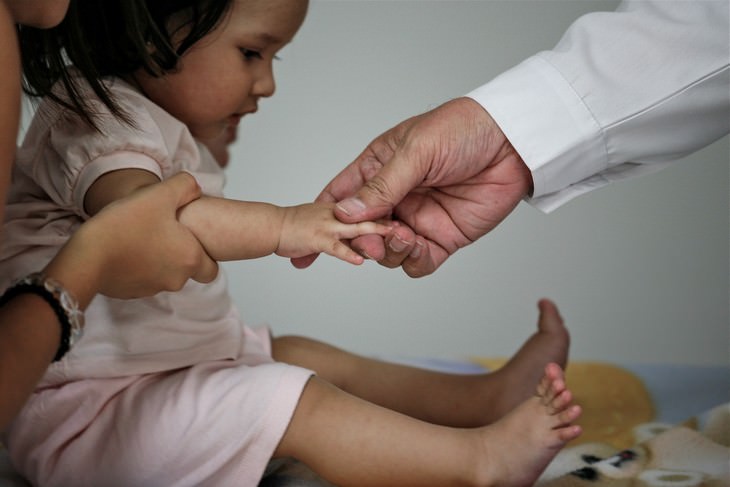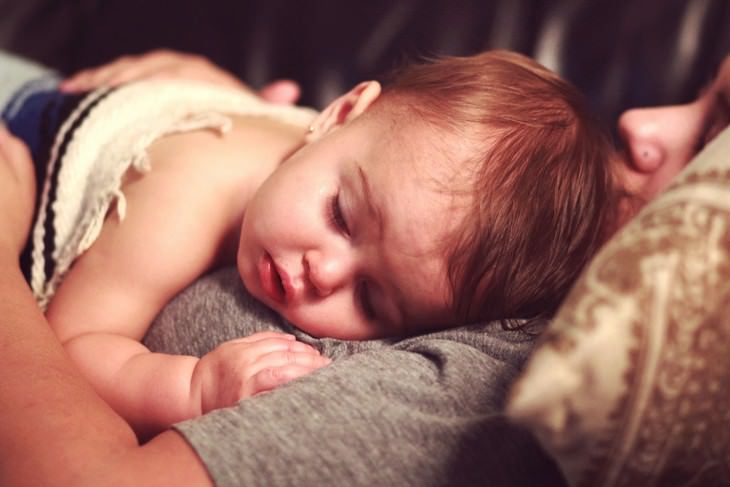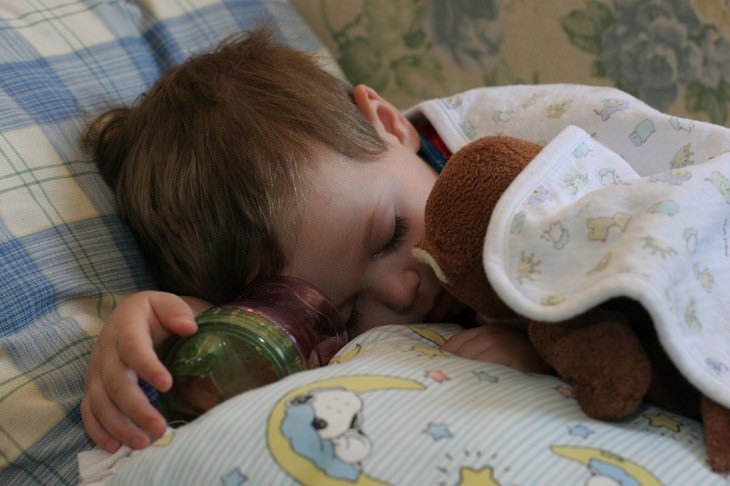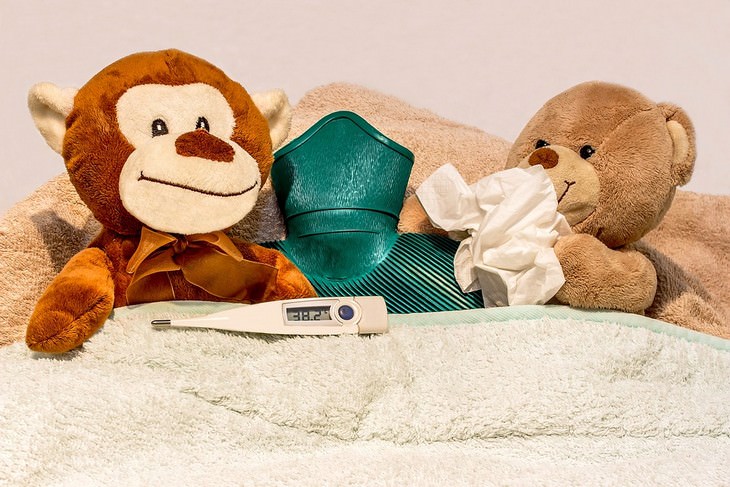Many systems in the bodies of young children are still not functioning at their peak capacity, so it is not uncommon to see various rashes and other changes appearing on their skin, which can worry many parents. This happens simply because children are particularly sensitive to infections, and their immune system can react severely when they are exposed to various substances or deal with health issues. Sometimes the immune system does not respond adequately, and the results of these two situations can be seen on the skin of children as rashes.
To help you differentiate between trivial and serious conditions and to know what treatment is required, it's important to be familiar with the following 8 skin problems and to know if there is a need to see a doctor if they appear. This can prevent many future complications, and every parent should be alert to changes in their children's skin condition and know this information.

1. Contact Dermatitis
Symptoms
- Tiny blisters with scales in the irritated area (common areas are the neck, waist, groin, and any part of the body that comes into direct contact with a substance)
- In some cases, puffy blisters that accumulate fluid and may be bothersome (in both cases, the dermatitis is not contagious but specific to the child and the inflamed area on their body)
Causes
As the name suggests, contact dermatitis occurs after prolonged contact with a substance that causes skin irritation, such as a clothing label, bracelets, various creams, and more. In babies, contact dermatitis sometimes appears when they drool, causing irritation to the chin and the appearance of blistering with scales.
Prevention and Treatment
To prevent cases of contact dermatitis, try to avoid contact between your child's skin and items that cause irritation. Remove labels from clothes, coat metal jewelry with protective material, and apply ointment to the baby's chin to protect it from excessive drool. If no allergies to this substance are known, you can apply 1% hydrocortisone, which does not require a prescription, or another ointment recommended by the pediatrician after examination.
2. Coxsackievirus/Hand, Foot, and Mouth Disease
Symptoms
Causes
Coxsackievirus infection occurs through exposure by contact, sneezing, or exposure to fecal particles in public areas. Since this virus has several strains, it's possible to be infected multiple times, with children under the age of 5 being particularly sensitive to it, though older children and adults may not show symptoms. The spread of Coxsackievirus intensifies in warm weather, so it is advisable to maintain good hygiene, especially in the spring and summer months.
Prevention and Treatment
As with most viruses, there is no medication for hand, foot, and mouth disease other than rest and plenty of fluids. To reduce fever, you can give your child an age-appropriate fever reducer and encourage them to drink to avoid dehydration. Maintaining proper hygiene and washing hands after contact with people or foreign substances is important to prevent this disease.

3. Eczema
Symptoms
- Patches of red, dry, and itchy skin with small bumps that first appear on the face or scalp (these patches can spread to other areas like elbows, arms, ankles, and knees)
- Itching in the inflamed areas of the skin
Causes
Doctors today are not sure about the exact main causes of eczema, but it's known to be accelerated or triggered when it's inherited, when there are seasonal allergies, external heat, or when experiencing mental stress.
Prevention and Treatment
Unfortunately, eczema cannot be prevented, but its symptoms and accompanying severe itching can be treated. To do so, it is important to avoid contact with substances and items that cause sensitivity and trigger outbreaks of inflamed areas. These are usually scented soaps and creams, perfumes (especially those containing alcohol), mold, animal dander, flower dust, coarse fabrics, and certain foods (egg protein is the most common trigger). Dry air also causes eczema flare-ups, so it's important to keep the skin hydrated by using special creams and washing with gentle soap that does not irritate or dry the skin. Doctors usually prescribe corticosteroid medications to treat the condition, and it's important to consult them when it flares up.
4. Fifth Disease
Symptoms
- Low fever accompanied by cold-like symptoms
- As the fever begins to subside after a few days, a strong redness appears on the cheeks that looks like the child was slapped
- After the redness on the face begins to fade, it spreads to other parts of the body like the limbs
- In older children, the disease is sometimes accompanied by painful joints
Causes
Fifth disease is a viral illness caused by infection with the parvovirus B19, which is common in late winter and spring. Children aged 5-15 are particularly sensitive to it and are the ones who tend to develop the characteristic symptoms of the disease.
Prevention and Treatment
Infection with the fifth disease virus can be prevented by maintaining hygiene and washing hands with soap or hand sanitizer when soap is not available. If your child gets sick, during the initial cold-like symptoms, they are contagious, and it's recommended to keep other children away. With the appearance of the cheek rash, the child enters a non-contagious stage, but it is still advisable to be cautious if there are other children around. Children who have had fifth disease are generally not likely to get it again.

5. Impetigo
Symptoms
- Red and painful bumps (initial stage)
- Blisters with a yellow-brown crust (advanced stage)
- Itching
Causes
Impetigo is caused by an infection resulting from exposure to staphylococcus or streptococcus bacteria, and it is common among children aged 2-6. The bacteria usually enter through wounds or cuts and cause unpleasant symptoms, with the disease being most common during the hot summer months.
Prevention and Treatment
In the case of impetigo, the best way to prevent it is to maintain good hygiene. If your child is injured, disinfect the wound as quickly as possible to prevent bacteria from penetrating the skin. When the disease breaks out, doctors will prescribe antibiotics according to the severity of the condition, with creams intended for small infected areas and liquid or pills used for more severe cases.
6. Petechiae/Purpura
Symptoms
- A rash of tiny red/purple/brown spots on the skin, appearing on the buttocks, limbs, and upper torso
- Joint pain including swelling and tenderness in the inflamed areas
- Swelling in soft areas like the scrotum and palms
Causes
The bursting of tiny blood vessels under the skin can occur after periods of severe coughing or similar conditions. In severe cases where the rash covers extensive areas, it's caused by a blood clotting problem resulting from a viral infection (idiopathic thrombocytopenic purpura (ITP)) or a bacterial infection from the meningococcus family, which also causes meningitis.
Prevention and Treatment
Meningitis in children can be prevented by giving the Hib vaccine, but there is no way to prevent the other causes of petechiae symptoms. The rash usually goes away on its own, but it's important to consult a doctor about ways to relieve the symptoms that cause it, such as heavy coughing, and to request a test to determine if there is an underlying serious issue that requires treatment.

7. Psoriasis
Symptoms
- Red and raised spots on the skin
- The merging of the spots into patches of skin with a silvery-gray, scaly, and thickened top (usually appears on the elbows and knees)
- In severe cases: patches in the navel, scalp, genitals, and also the buttocks
- Nails with faded grooves (sometimes the nails fall off as a result of the disease)
Causes
It is now known that genetics play a major role in cases of psoriasis, and if one parent has the disease, there is a chance their children will also have it. However, there is no information regarding the exact causes of this autoimmune disease, which causes the production of skin cells at a faster rate than usual, leading to the formation of scales.
Prevention and Treatment
Half of the cases of psoriasis in children are caused by an infection, mainly throat infections, so it's important to avoid dirty places or contact with sick children. Hygiene, as always, is extremely important, and it is advisable to wash hands or use a sanitizer after contact with strangers or other children. Regarding treatment, in cases of psoriasis caused by infection, doctors will usually prescribe antibiotics. In other cases, they will prescribe steroid ointments to relieve symptoms and skin irritation, but there is currently no cure that completely eliminates the disease.
8. Roseola
Symptoms
- High fever
- Cold-like symptoms
- Loss of appetite
- Restlessness
- Pink-red rash that does not itch on the upper body, which may spread to the face and limbs (occurs after the fever subsides)
- About 15 percent of children with roseola have febrile seizures due to the high fever. The seizure lasts about 2 minutes and does not endanger the child, but it's important to see a doctor if this happens to your child
Causes
Roseola is caused by exposure to a virus that spreads through coughing. It's common among children aged 6 months to 2 years, and it usually does not recur after that. After exposure to the virus, it incubates in the body for two weeks before symptoms appear.
Prevention and Treatment
If you know that a child in your child's environment has roseola, prevent contact between them and try to avoid sharing food or drink in such cases. Keep your child's hands clean so that they do not put them in their mouth if they have been exposed to the virus. Since roseola is caused by a virus, there is no antibiotic or medication for it, and doctors will recommend giving fever-reducing medicine until the rash disappears.




